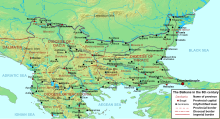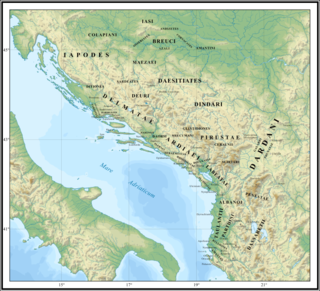
In classical antiquity, Illyria was a region in the western part of the Balkan Peninsula inhabited by numerous tribes of people collectively known as the Illyrians.
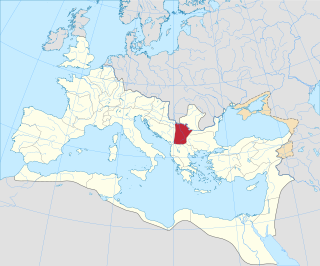
Moesia was an ancient region and later Roman province situated in the Balkans south of the Danube River. Moesian Province was first administered by governor of Noricum as 'Civitates of Moesia and Triballia'. It included most of the territory of modern eastern Serbia, Kosovo, north-eastern Albania, northern parts of North Macedonia, Northern Bulgaria, Romanian Dobruja and small parts of Southern Ukraine.

The Illyrians were a group of Indo-European-speaking people who inhabited the western Balkan Peninsula in ancient times. They constituted one of the three main Paleo-Balkan populations, along with the Thracians and Greeks.
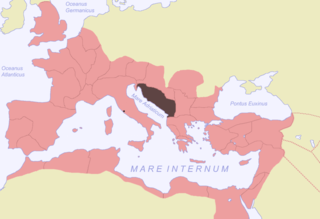
Illyricum was a Roman province that existed from 27 BC to sometime during the reign of Vespasian. The province comprised Illyria/Dalmatia in the south and Pannonia in the north. Illyria included the area along the east coast of the Adriatic Sea and its inland mountains, eventually being named Dalmatia. Pannonia included the northern plains that now are a part of Serbia, Croatia and Hungary. The area roughly corresponded to part or all of the territories of today's Albania, Kosovo, Montenegro, Serbia, Bosnia and Herzegovina, Croatia, and Slovenia.
Justiniana Prima was an Eastern Roman city that existed from 535 to 615, and currently an archaeological site, near modern Lebane in the Leskovac region, Serbia. It was founded by Emperor Justinian I (527-565) and served as the metropolitan seat of the then newly founded Archbishopric of Justiniana Prima, which became the main church administrative body of the central Dardania with jurisdiction from Praevalitana to Dacia Ripensis. Justinian Prima was originally designed to become the capital of the prefecture of Illyricum, but for reasons likely related with its status near the Roman frontiers of the 6th century CE, Thessaloniki was preferred. It was abandoned less than 100 years after its foundation.

Dacia Ripensis was the name of a Roman province in the northern Balkan peninsula, immediately south of the Middle Danube. Its capital was Ratiaria. It was a district less urban than neighbouring Dacia Mediterranea and more militarized; "military camps and forts, rather than cities, were typical of the province". Besides Ratiaria, Oescus was the major settlement.

Dacia Mediterranea was a late antique Roman province, whose capital city was Serdica.

Doclea or Dioclea, also known as Docleia or Diocleia, was an ancient Illyrian, Roman and Byzantine city, in the region of the Docleatae tribe, now an archeological site near Podgorica in modern Montenegro.

The Diocese of Dacia was a diocese of the later Roman Empire, in the area of modern western Bulgaria, central Serbia, Montenegro, northern Albania and northern North Macedonia. It was subordinate to the Praetorian prefecture of Illyricum. Its capital was at Serdica.

Dardania was a Illyrian province in the Central Balkans, initially an unofficial region in Moesia (87–284), and then a province administratively part of the Diocese of Moesia (293–337). It was named after the tribe of the Dardani who inhabited the region in classical antiquity prior to the Roman conquest.

Much of the territory of the modern state of Serbia was part of the Roman Empire and later the Eastern Roman Empire. In particular, the region of Central Serbia was under Roman rule for about 800 years, starting from the 1st century BC, interrupted by the arrival of the Slavs into the Balkans during the 6th century, but continued after fall of the First Bulgarian Empire in the early 11th century and permanently ended with the rise of the Second Bulgarian Empire in the late 12th century. The territories were administratively divided into the provinces of Moesia, Pannonia and Dardania. Moesia Superior roughly corresponds to modern Serbia proper; Pannonia Inferior included the eastern part of Serbia proper; Dardania included the western part of Serbia proper. After its reconquest from the Bulgarians by Emperor Basil II in 1018, it was reorganized into the Theme of Bulgaria.

The Cape of Rodon or Cape of Skanderbeg is a rocky cape on the Adriatic Sea north of Durrës, Albania. On the Cape is the Rodoni Castle, built by Skanderbeg in 1463. and a Saint Anthony Church. Further south in the bay between the cape and Rrushkull Reserve there exist several beach resorts like Fshati Turistik Lura while Lalzit Bay Resort is under construction.
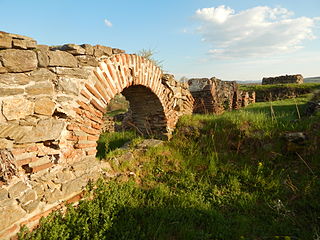
Archbishopric of Justiniana Prima was an Eastern Christian autonomous Archbishopric with see in the city of Justiniana Prima and jurisdiction over the Late Roman Diocese of Dacia in central parts of the Southeastern Europe.

The Diocese of Moesia was a diocese of the later Roman Empire, in the area of modern western Bulgaria, central Serbia, Montenegro, Albania, North Macedonia, and Greece.

Moesia Prima was a frontier province of the Late Roman Empire, situated in the central parts of present-day Serbia, along the south bank of the Danube River. Provincial capital was Viminacium, near modern Kostolac in Serbia).
Illyrology or Illyrian studies is interdisciplinary academic field which focuses on scientific study of Illyria and Illyrians as a regional and thematic branch of the larger disciplines of ancient history and archaeology. A practitioner of the discipline is called Illyrologist. His duty is to investigate the range of ancient Illyrian history, culture, art, language, heraldry, numizmatic, mythology, economics, ethics, etc. from c. 1000 BC up to the end of Roman rule around the 5th century.

The Culture of ancient Illyria or Illyrian culture begins to be distinguished by increasingly clear features during the Middle Bronze Age and especially at the end of the Late Bronze Age. Ceramics as a typical element is characterized by the extensive use of shapes with two handles protruding from the edge as well as decoration with geometric motifs. At this time the first fortified settlements were established. The local metallurgy produced various types of weapons on the basis of Aegean prototypes with an elaboration of artistic forms. The main tools were the axes of the local types "Dalmato-Albanian" and "Shkodran", as well as the southern type of double ax. Spiritual culture is also expressed by a burial rite with mounds (tumuli) in which a rich material of archaeological artifacts has been found.
